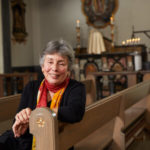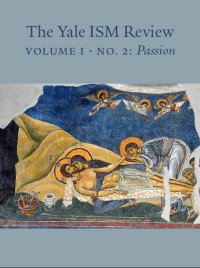Teresa Berger
This sermon on John 18:1–19, 42 was delivered at St. Thomas More Chapel and Center at Yale University on Good Friday, March 29, 2013.
“And there they crucified him.” The lengthy Passion narrative with its betrayals, sufferings, and the host of people who crowd the narrative—disciples, Judas, soldiers, guards, a high priest’s slave named Malchus, Annas, Caiphas, the gatekeeper-maid, Peter, another slave of the High Priest, Pilate, the two who are crucified with Jesus—all of this turmoil comes to a halt in one short sentence: “And there they crucified him.”
It will not be long before another short sentence brings the whole of Jesus’s earthly life to its close: Jesus “hands over his spirit.” He tastes death. Jesus, the human face of God, who entered our human existence, experiences the end of that existence.
On one level, Jesus’s death is simply the other end of the arc that began with his birth: He truly became one with us, in being born. He truly now becomes one of us in dying. Granted, this death came at a relatively early point in life—but then, so do many deaths in our world. And yes, Jesus’s death did not only come early and was violently inflicted; it was also exceedingly painful, indeed torturous. Yet Jesus’s death was probably no more torturous than the dying of a young woman on a bus in India some months ago. The young woman had been abducted, repeatedly violated in the most brutal, dehumanizing ways imaginable, savagely beaten and then left to die.
Why, then, have people for close to two thousand years gathered around the story of Jesus’s Passion and death? And why do we continue to ask each other, in the words of the song we will soon sing: “Were you there?” “Were you there when they crucified my Lord?” The answer for all of us after all is: No. We were not there, two thousand years ago. Yet the liturgy of Good Friday labors, as no other liturgy in the year, to render present Jesus’s dying in our midst, to make it coterminous with our own lives. I suggest to you that in doing so, this liturgy is seeking to embody a particular truth: Good Friday is about being there, about being present, about com-passion, and suffering with. As it was on that Friday so long ago, so it is also today.
Some months ago I was struck by the report of a conference on palliative medicine. The conference focused on doctors caring for terminally ill patients. One of the presenters reported that many doctors feel compelled to “do something” in the face of death, often in the form of continuing aggressive treatments, although the doctors themselves know that those treatments are futile. The palliative care expert suggested that instead of “doing something,” one’s calling might rather be this: “Don’t just do something, stand there!”
I myself by now am old enough (and have lived in this culture for long enough) to have heard many Good Friday sermons that preach the opposite, namely: “Don’t just stand there, do something: go, give, share, love!” No doubt those are crucial imperatives. Yet there is a danger if they become the only and the whole truth we embrace on Good Friday. Why? Because this message—“Do something!”—suggests that simply being there, standing at the foot of the cross, is an inadequate and poor response. We need to do something, so the thinking goes, for Jesus’s death to be meaningful—as if Jesus’s death on the cross were meaningless, unless we ourselves give it meaning.
In and for this liturgy on the Friday of the Passion of the Lord, I suggest to you that, on the contrary, it is not us and our doing that give meaning to Christ’s death. God has already done that, when God faced down dying and death on Good Friday and on Easter morning spoke a powerful “no” to the finality of the death of Jesus. That act, that doing of God—rather than our own—is the ultimate word on the meaning of Good Friday.
Our calling in this liturgy is to let Christ’s death give meaning to our lives. And, for that to take place, our presence, our “just standing there” is all the liturgy asks of us. Yet this is no easy task. “Just standing there” actually is a profound challenge, especially for people like us. We do not just want to stand there, and that with empty hands. We want to do something, and move into action. If nothing else, such action at least lessens and covers our own feelings of helplessness. Yet, “just standing there”—truly being present to the agony of the other and to our own helplessness in the face of it—is the calling of this liturgy. It is also what those few disciples did who did not flee: Mary the mother of Jesus, the beloved disciple, the other women at the foot of the cross. What, after all, can disciples do when the feet of the one they were following are nailed to a cross? These few disciples remained at the feet of Jesus and the foot of the cross, standing there in com-passion, in suffering with. Such presence, such real presence, is our calling too, in this liturgy. The doing will follow, and more deeply, the deeper we have been present to the agony of the cross.
Where is the Good News in this? The Good News, for our “being there,” is that Good Friday is not primarily about remembering as a form of thinking back. Rather, Christians believe that the One who was crucified and died is also the One who continues to live in our midst as the Risen One. The Friday of the Passion of the Lord, after all, is not really about remembering the death of a good, decent, wrongfully convicted human being; it is about so much more. Good Friday reveals God’s gift of God’s self unto death for the life of the world, a gift that gives meaning to our lives and redeems, not only us but the whole cosmos.
What would it mean, then, for you simply to practice presence in this Good Friday liturgy? To let the meaning of your life—its deepest mystery, its places of profound pain where quick fixes are impossible—reveal itself as you stand under the cross, as you venerate this cross as the place where the feet of Jesus, whom you seek to follow, were brought to a halt. Simply stand there for a moment, at the foot of the cross. And hear your name being called from this place of presence: Mary mother of mercy; John beloved disciple; Elisabeth my sister; Carolyn my friend; Father Eddie and Father Bob; Katie, Janet, Stefan, Teresa . . . Know that your very being is redeemed and made whole at the foot of the cross and in the presence of the Crucified One.
 Teresa Berger is Professor of Liturgical Studies and Thomas E. Golden Jr. Professor of Catholic Theology at the Yale Institute of Sacred Music and Yale Divinity School. Her scholarly interests lie at the intersection of theological and liturgical studies with gender theory. Her publications include Gender Differences and the Making of Liturgical History; Dissident Daughters: Feminist Liturgies in Global Context; and Fragments of Real Presence: Liturgical Traditions in the Hands of Women. She has also written on the hymns of Charles Wesley and on the nineteenth-century Anglo-Catholic revival. She was editor of Liturgy in Migration: From the Upper Room to Cyberspace, essays from the 2011 ISM Liturgy Conference.
Teresa Berger is Professor of Liturgical Studies and Thomas E. Golden Jr. Professor of Catholic Theology at the Yale Institute of Sacred Music and Yale Divinity School. Her scholarly interests lie at the intersection of theological and liturgical studies with gender theory. Her publications include Gender Differences and the Making of Liturgical History; Dissident Daughters: Feminist Liturgies in Global Context; and Fragments of Real Presence: Liturgical Traditions in the Hands of Women. She has also written on the hymns of Charles Wesley and on the nineteenth-century Anglo-Catholic revival. She was editor of Liturgy in Migration: From the Upper Room to Cyberspace, essays from the 2011 ISM Liturgy Conference.
____
This material is licensed under a Creative Commons Attribution 4.0 License.
Recommended Citation: Berger, Teresa. (2015) “Don’t Just Do Something, Stand There!,” The Yale ISM Review: Vol. 1: No. 2, Article 3. Available at: https://ismreview.yale.edu
View article as a PDF: Don’t Just Do Something, Stand There
